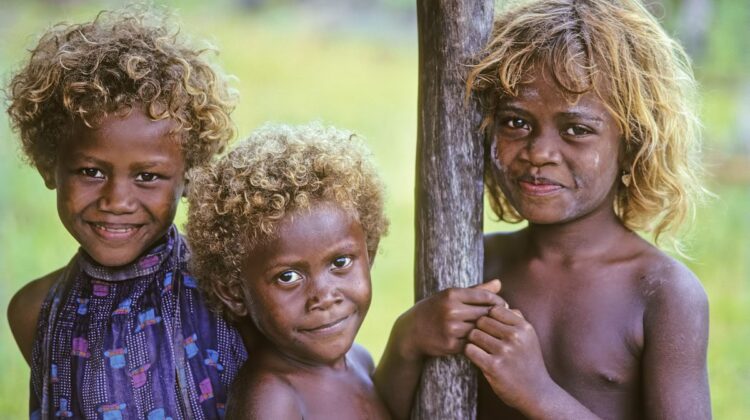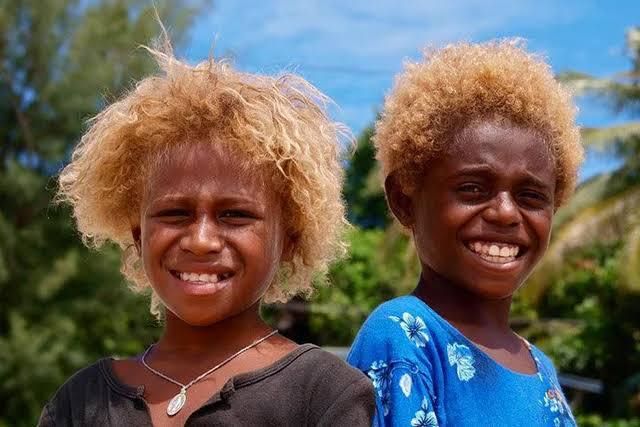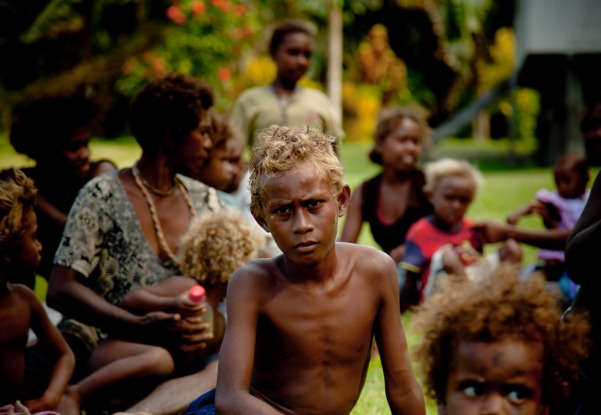
Have you ever seen an African-American with blond hair?
Melanesians are the black island people who moved thousands of years ago to the south Pacific. The initial inhabitants of the collection of islands now known as Melanesia were most likely the progenitors of today’s Papuans. They are an Oceania sub-region that stretches from the western edge of the Pacific Ocean to the Arafura Sea and eastward to Fiji. Vanuatu, the Solomon Islands, Fiji, and Papua New Guinea make up the region. Thus, indigenous Melanesian populations are frequently divided into two major groupings based on language distinctions, such as Papuan-speaking and Austronesian-speaking groups, culture, or genetic origins.

When it comes to dark complexion and blonde hair, the Melanesian people of the Solomon Islands are the focus of attention. There are various hypotheses as to how they got their blonde hair, ranging from sun and salt whitening to heavy fish consumption to genetic legacy from mixed breeding with the Americans/Europeans who created the island.
Melanasia’s Prevalence of Blond Hair
Blond hair evolved independently in Melanesia, where Melanesians of several islands (along with some indigenous Australians) are one of the only tribes with blond hair who are not descended from Europeans.

Therefore, it is rare in native populations outside of Europe and North Africa. However, as with blond hair that arose in Europe and parts of Asia, the incidence of blond hair is more common in children than in adults, with hair tending to darken as the individual matures and this has been traced back to an allele of TYRP1 unique to these people and is not the same gene that causes blond hair in Europeans.
The Diversification and Differentiation among the Melanesians
Studies found a high rate of genetic differentiation and diversity among the groups living within the Melanesian islands, with the peoples not only distinguished between the islands but also by the languages, topography, and size of an island. Such diversity developed over the tens of thousands of years since initial settlement, as well as after the recent arrival of Polynesian ancestors at the islands. Papuan-speaking groups in particular were found to be the most differentiated, while Austronesian-speaking groups along the coastlines were more intermixed.

Since the late 20th century, further DNA analysis has taken research into new directions, as more Homo erectus races or sub-species have been discovered. Moreso, the evidence from Melanesia suggests their territory extended into southeast Asia, where ancestors of the Melanesians developed.
The practices of the Melanesians
The Melanesians living in Eastern Indonesia mostly practice Christianity, in contrast to the Malay and Javanese people in the Western part of the archipelago, who mostly practice Islam. Until recently, the indigenous Melanesian people practised cannibalism, head-hunting, kidnapping and slavery like the Asmat tribe, but with contact with Europeans, the population is now predominantly Christian. However, some still practice a rural lifestyle.

Evidence suggests that the cultural, linguistic, and political fragmentation that prevailed at the time of European arrival, with a half-dozen languages and cultures often represented on a single island, was partly a product of transformation that had occurred during the previous 2,000 years even though their pre-history of most of island Melanesia has not been fully documented. However, hierarchical political systems and associated trade networks seem to have broken down during this period and appear to have been accompanied by the increasing separation of language or dialect groups.
The pressures of Christianisation and Westernisation have caused the indigenous peoples of Melanesia to become part of the world economic system and this has operated for more than a century in some areas. By the early 21st century, even the most remote regions had become accessible and transformed. Also, different Christian denominations, and even individual missionaries, have in varying degrees been sympathetic to and knowledgeable about local languages and cultures. Together, missionary work and the imposition of colonial rule eliminated a variety of cultural traditions, some of which were quite intricate and rich and others of which were violent and exploitative.

Elites are increasingly sharing a shared (Westernised and Local) culture, as well as common political and economic objectives that cross cultural, linguistic, and geographic lines. As a result, cultural nationalist ideologies have centered on traditional customs (such as kastom) and “the Melanesian way” (their native way of life), which has emerged as a key theme among them. The emphasis on traditional culture as a source of identity manifests itself in the preservation or resuscitation of old exchange mechanisms. Traditional cultural components, such as ceremonial trade, dance and song, and oral traditions, that had long been suppressed by more orthodox and evangelistic strains of Christianity, have been rehabilitated by art festivals, cultural centers, and kastom philosophies.

This is magnificent. They look like they are so happy.
Thais is once again the White version or description of a population that is not white and you all tell them were they belong and who they are.
I”m quite confused by the remark “Americans/Europeans who created the island” I lived in the Solomon Islands for decades (there are about a thousand islands in the Solomons) none of which to my knowledge were created by anyone, apart from very small “artificial” islands, built by the people of Malaita in their lagoons. Love the beautiful photographs, brings back happy memories. Best Wishes.
The melanated race are beautiful people. 🙂
“…Americans/Europeans who created the island” really?
I lived and worked in both Melanesia and Micronesia and saw many with the blonde hair. Its very outstanding. I spent over 12 years in the country of PNG. I married a Highlander am married into the Asaro tribe.
All skin; All hair; All people; in fact, All life forms; Just Beautiful! 🛎
They are not African American. You need to edit that by-line
They are not “African-Americans” as they are neither from Africa, nor are they Americans. I don’t understand using that terminology.
What beautiful people this country has. Thanks for the education into other parts of the world.
Why does the headline say African American if they are from Indonesia? Thus is a mistake.
Cannibalism in these cultures, I gather from my college couses in Anthropology, in New Guinea was practiced by warriors victorious in battle. on their defeated enemies. Tribal warfare occurred often in ancient times in New Guinea. The ceremonial eating of defeated warriors was seen as a way of honoring those defeated warriors. The native term “long pig” may have referenced this custom.
Many of these societies in ancient times were primarily agricultural, and depended upon the cultivation of yams as a staple food. Most ancient agricultural societies did not practice cannibalism as planted crops were their main sources of food.
I have heard an argument between a black girl with bleach blonde hair and white girl who while arguing stated black people never have or will have natural blonde hair. I guess as modern as we are knowledge fails a lot of us this article proves people need to let people just be. No one trait belong solely to anyone the variations of beauty in the world is incredible magnificent and should just be appreciated. So many black people with blue eyes also exists . Its time to just see God’s beautiful creations and be thankful
So glad that these people could get back some of there heritage that was robbed from them so many years ago. Live and Let Live❤️
I have known of these people since Sixty Minutes introduced them. Beautiful they are.
Beautiful Children. I would love to see more pics of them.
The blonde hair is a nice contrast with their beautiful dark skin.
This article has nothing to do with Americans, besides that, I see African Americans with blonde hair every day and as long as they make Ms Clairol we will continue to see them 🤣🤣
Thank you for sharing this. I love learning about new cultures and what a beautiful one this is. I’m glad to see, even though modernized to some point, they are keeping some of their true lifestyle and culture. .
Really genius! Did you read that they actually did genetic testing? And, what indication was given that they live outdoor.
I think it’s interesting that you state their ancestors travelled from Africa all the way to the Pacific. Wouldn’t it be more feasible they came from Australia, which has the oldest indigenous peoples? Much closer in distance, resemblance and indigenous Australians also have blonde hair.
These humans are absolutely beautiful 😍
They absolutely are descendants of Africans!